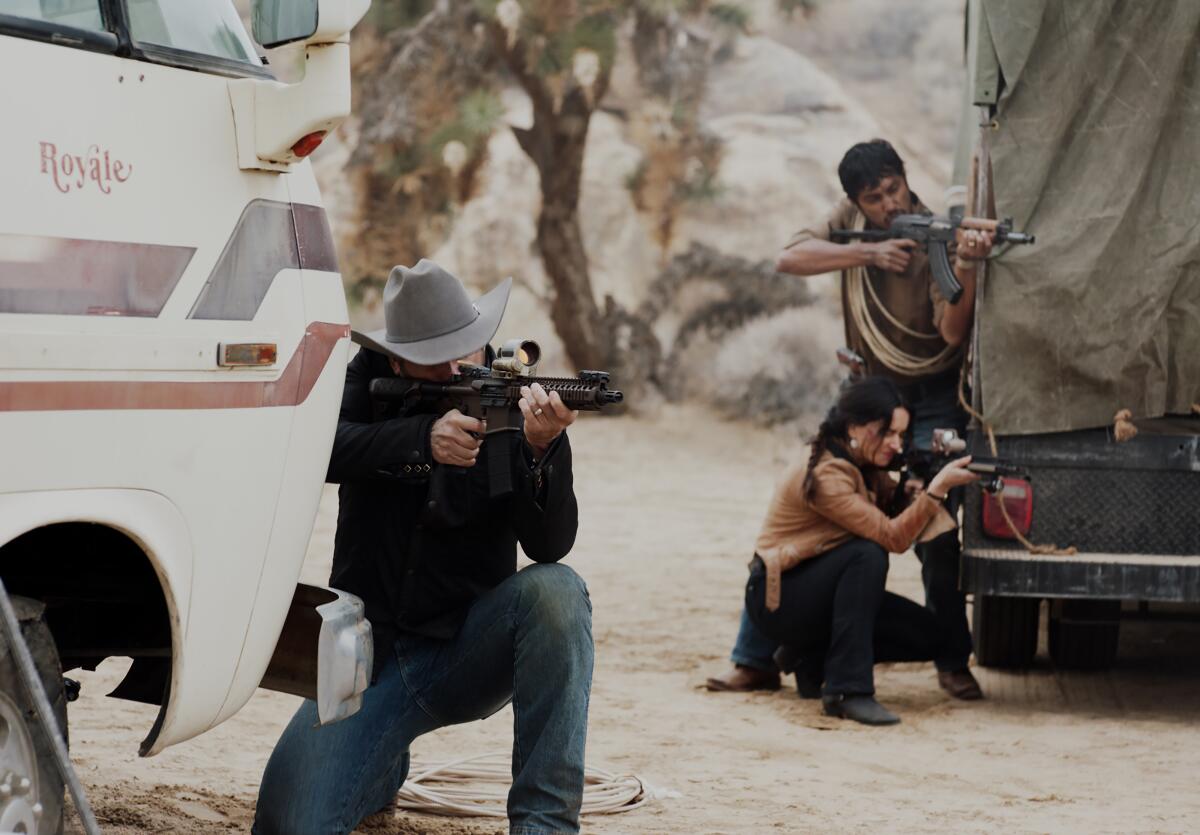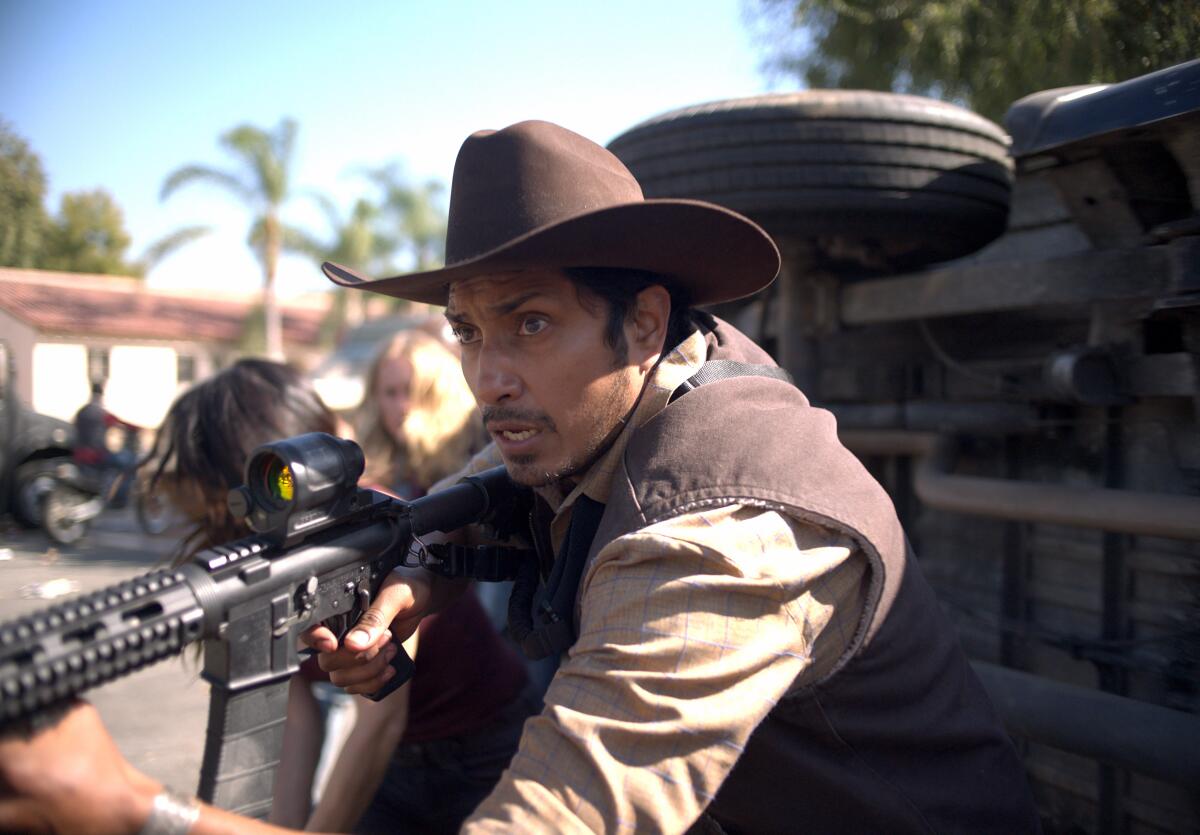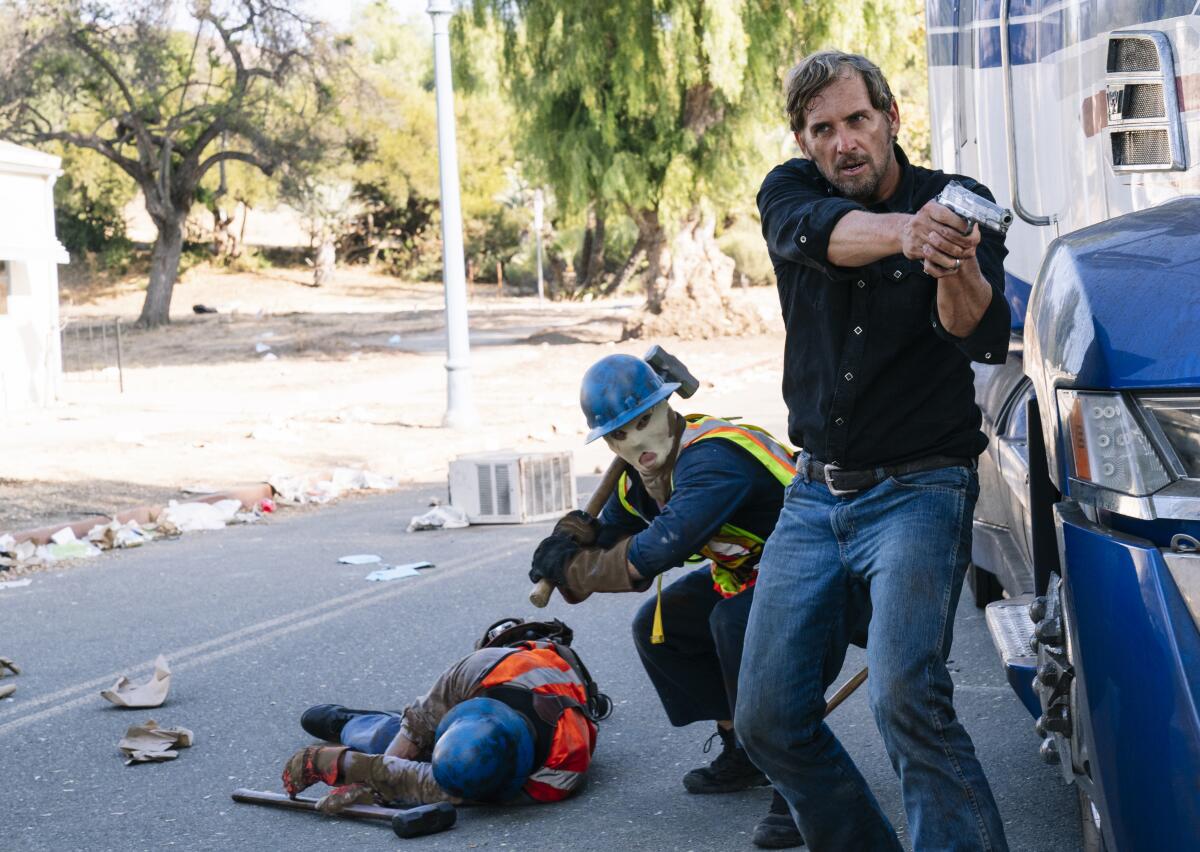Immigrant heroes. White supremacist villains. How ‘Forever Purge’ struck a chord

With its borderland backdrop and rednecks-vs.-immigrants shoot-’em-ups, “The Forever Purge” might sound like a bleak social commentary on current U.S.-Latin American relations.
But for the cast and crew behind the fifth installment of the Universal Pictures action-horror saga, making “The Forever Purge” was an exercise in bilingual teamwork and cross-cultural enlightenment — not exactly the usual Hollywood recipe for a genre franchise.
The dystopian series’ most politicized offering so far, “Forever Purge” opened in theaters ahead of the July 4 holiday weekend and stars two Mexican actors, Tenoch Huerta and Ana de la Reguera. The dialogue lopes freely between English and Spanish.
And the screenplay, by James DeMonaco, centers on a heroic Mexican immigrant couple fleeing a a vicious drug cartel to seek refuge in Texas, where they’re confronted by white supremacist goons who’ve turned the Purge — a yearly 12-hour orgy of murder, rape and arson permitted by America’s totalitarian rulers — into a permanent license to terrorize and kill.
DeMonaco, an Italian American New Yorker who directed the series’ first three installments, partly credits the latest installment’s cultural alertness to his conversations with Mexican director Everardo Gout. Those exchanges gave Gout permission to pepper the screenplay with personal details and sharpen the dialogue of the Latino characters with streetwise Mexican modismos.

“My research only took me so far, because I don’t know the experience of Mexicans coming to America, and in that sense, the partnership between us was invaluable,” DeMonaco said. “We had this discourse between an American guy from New York and a Mexican guy to achieve something that I hope feels very authentic to both the characters and the times we’re living.”
Gout, for his part, said he was grateful to be granted “the freedom to make the acting tone more realistic, so that the Latino part was well told,” and to be able to “drive the irony” behind one of the movie’s most trenchant touches: desperate gringo refugees “illegally” crossing the southern border into Mexico to flee the Purge.
Channeling America’s anxieties and exaggerating some of its darkest realities, the series launched in 2013 with “The Purge,” followed by “The Purge: Anarchy” (2014), “The Purge: Election Year” in 2016 and “The First Purge” two years later.
“The whole franchise always had a political bent,” DeMonaco said. “But I think that over the years it started to be more and more political due to all the headlines and national news around us.”
His original idea for a fifth film was a love story about a Mexican couple on the run, “seeking the American dream and wondering if the dream was still alive, at least for people like them.”
“The studio told me, ‘That’s not a horror movie!’ But I said, ‘Give me time!’”
When filmmaker James DeMonaco and his longtime production partner Sébastien Lemercier started working on “an X-rated treatise on violence,” they had no idea they would eventually conceive of “The Purge.”
DeMonaco then came up with the twist of white supremacists determined to keep their state-sanctioned bloodbath raging indefinitely — a literal “Forever Purge” — a notion he said was inspired by the daily mayhem stirred up throughout Donald Trump‘s presidency. The fleeing protagonists, Adela and Juan, played by De la Reguera (“Army of the Dead,” “Narcos”) and Huerta (“Tigers Are Not Afraid,” “Narcos: Mexico), came into focus based on real cases of the hundreds of missing and murdered women in Ciudad Juárez, Mexico.
The Mexico City-born Gout worked on several American television series such as National Geographic‘s “Mars” before cowriting his future calling card, “Days of Grace” (“Días de gracia”), a 2011 Mexican crime thriller set during the World Cup and costarring Huerta.
Gout recalled that the invitation to join “The Purge” family was completely unexpected. He joked that at first he feared DeMonaco and producer Jason Blum might’ve confused him with his Oscar-winning countryman Alfonso Cuarón — “I congratulate you on ‘Roma,’ man, that was incredible for you!” — then later would realize their mistake.
DeMonaco said it was clear from the start that the film needed a Mexican director, “and Everardo was on the top of the list.”
“And then, when we spoke, I realized we spoke the same cinematic language, we wanted to say the same things about the immigrant experience, and I found out that he even had some experience with the cowboy universe that we show, because someone from his family had lived on a ranch,” DeMonaco said.
Part of what sold Gout on the project was that he had the final word in choosing the male lead. DeMonaco acknowledged having doubted at one point that Huerta was appropriate for the role.
“I thought that potentially his accent could be a problem for the American audience,” he said. “But Everardo didn’t waver for a second about Tenoch. He was the only name he ever brought, and he fought all the time for him.”

For de la Reguera, the role of Adela offered the chance — still relatively uncommon for Latina film characters — not only to brandish weapons but to appear as strong, and sometimes even stronger, than her husband.
“I loved casting her,” said Gout. “I want to see more films where the protagonists are mature women who are also badasses.”
In collaboration with the director, de la Reguera tweaked the dialogue to make it sound like what you’d hear spoken while strolling Tepito or Tijuana. Sometimes that meant replacing a flat English phrase with a more pungent Spanish one, de la Reguera said.
“For example, we started by saying ‘kill him!’ and we ended with ‘¡Quiébrenselo!’” she recalled. “Adela is a loving, sweet and brave woman, but she is also a woman who can take up arms, who is not afraid of anything.”
Though the series relies on a fairly conventional (if well-staged) genre mix of high-speed action, smash-and-grab editing and creepy shock effects, the critical approval it has received in some quarters stems from its skill in injecting sharp satirical asides into the melodrama.
“Years ago,” DeMonaco said, “I heard this thing Scorsese was talking about ... the ‘smugglers’ cinema, when the studio directors in the ‘40s and the ‘50s didn’t want to make westerns or war movies anymore but were contracted to do so, so they started smuggling political ideas into those films.
“That was continued by John Carpenter and George A. Romero in the ‘70s and ‘80s, and I think a lot of the great sci-fi and horror movies do the same.”

Accordingly, the filmmakers hope that at least some viewers will discern the political subtext of Mexican migrants teaming up with sympathetic norteamericanos to outwit, and out-hit, racist killers.
“You never know how people are going to react to a movie,” Gout said, but “anyone who goes to see an installment of ‘The Purge’ and does not know that he is going to see something subversive was in the wrong room. He should have gone to see one of ‘Fast & Furious’ or something like that.”
According to some reports, “The Forever Purge” cost $18 million to make, compared to the initial movie’s $3 million budget. Although the story takes place mostly in Texas and on the border, it was filmed mainly around Los Angeles, while a smaller unit recorded material in the Texas cities of El Paso and Marfa.
“The biggest obstacle was the budget,” Gout said, “because you read on one page ‘America collapses.’ And they said: ‘Where do you want us to put the 30 extras?’”
To compensate, Gout said, “Every day you had to invent ways of seeing and not seeing the world that was outside” the main action. For instance, when shooting car-interior scenes, the camera flashes briefly to images of the surrounding chaos and destruction.
“But we focus on their faces to give the impression that it is something that is happening all over the place,” Grout explained. He also recalled a lesson he’d gleaned from Steven Spielberg’s work on “Jaws.”
“Because the damn [mechanical] shark never worked, the movie came out so much better, because the shark is not in front of you all the time and that’s a lot scarier than staring at its snout nonstop.”
More to Read
Only good movies
Get the Indie Focus newsletter, Mark Olsen's weekly guide to the world of cinema.
You may occasionally receive promotional content from the Los Angeles Times.











